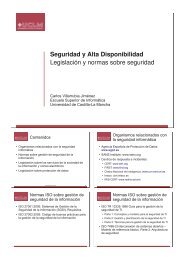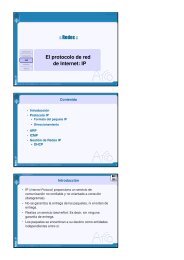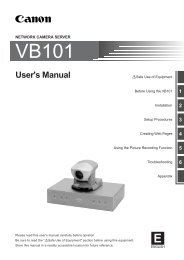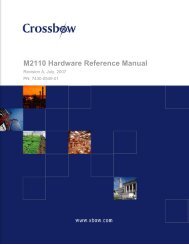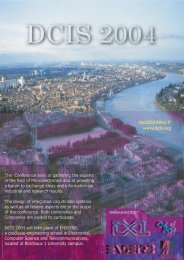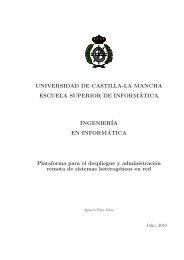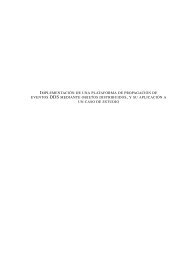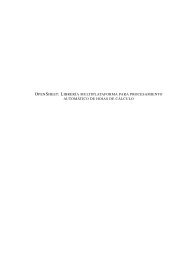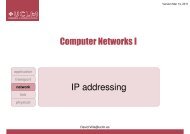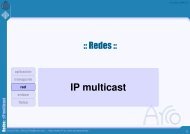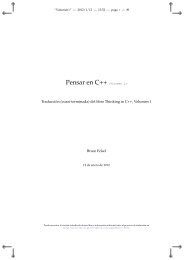tion, is addressed by coping with a set of challenges. One of these challenges consists in recognizinghuman activities. In or<strong>de</strong>r to overcome the disadvantages of a traditional reactive interaction, in whichcomputers only respond to direct user requests, it is necessary to replicate the human assistant role,in favor of a more proactive mechanism. The i<strong>de</strong>a behind the assistant simile is to <strong>de</strong>vise a systemcapable of foreseeing user requests and to respond to them by offering users those services that mightcomply with their requirements. This challenge unavoidably entails the task of gathering data froman inherently dynamic and open world, which makes more difficult the interpretation of such data.No won<strong>de</strong>r the main hurdle is in un<strong>de</strong>rstanding the meaning of sensor data as a whole rather than asisolated data.An additional challenge addressed by this project is the lack of standards that characterize the currentpervasive contexts. At different levels, the lack of standards affects the communication betweendifferent <strong>de</strong>vices or the services they provi<strong>de</strong>, or how to discover and integrate new <strong>de</strong>vices appearingin the context, or how to combine information that comes from different sources. It cannot be ignoredthat the main concern of Ambient Intelligence is to enact a context in which <strong>de</strong>vices are merged withthe background. In this context access to information is provi<strong>de</strong>d in a pervasive and seamless manner.In or<strong>de</strong>r to address such challenge, it is an essential requirement to provi<strong>de</strong> interoperability supportamong services and <strong>de</strong>vices from different vendors. This challenge has been tackled by building acommon and <strong>de</strong>fined software infrastructure.The project en<strong>de</strong>d up in 2007, with successful results in a wi<strong>de</strong> range of fields, such as thoseinvolved in perceptual technologies (person tracking, speech recognition, or emotion recognition)and services. However, the conclusions drawn after the end of the project lead to the need for furtherefforts in several directions. For example, <strong>de</strong>spite claiming to use real data, these were only retrievedthrough supervising a meeting room. It is necessary to open up the supervised areas to additionalscenarios and check whether the implemented mechanisms are capable of <strong>de</strong>aling with the situationstaking place. Moreover, sensor data could have been of a greater help if they had been managed incoordination, rather than being consi<strong>de</strong>red in isolation.The Cognitive Robot Companion (COGNIRON) [24] Project 2 is an initiative fun<strong>de</strong>d by theEuropean Union, mainly inten<strong>de</strong>d to <strong>de</strong>sign and build a robot that, endowed with raw capabilities andthe ability to learn and un<strong>de</strong>rstand from interacting with humans, it is capable of imitating humanbehavior.This project involves several multidisciplinary fields, such as human activity recognition, spatialawareness, or social skills, among some, achieving a breakthrough outcome in some of these fields ofknowledge. It is worth mentioning the contributions ma<strong>de</strong> to the field of <strong>de</strong>tection and un<strong>de</strong>rstandingof human activity based on body tracking. Additionally, the context-sensitive path planning implementedby this project enables the robot to perform more intelligent planning, based among some, onthe semantic knowledge it holds about specific cultural issues. The high level knowledge held by therobot is what enables it to perform human-like reasoning about plans.Due to the fact that the COGNIRON project was mainly about Robotics, it can be argued that thisshould not be listed along with those that are specifically addressed to Ambient Intelligence. However,the conclusions and contributions of this project are synergistic to the Ambient Intelligence field,especially those involving learning and un<strong>de</strong>rstanding capabilities, context-awareness, or <strong>de</strong>cisionmaking.This project is also mentioned here because, <strong>de</strong>spite being encompassed in a different field ofknowledge from Ambient Intelligence, it does tackle the problem of how to address unexpected situa-2 http://www.cogniron.org/final/Home.php18
tions. The non-<strong>de</strong>terminism implicit in communicative activities requires a flexible system to supportthe human-robot collaboration. In or<strong>de</strong>r to achieve such flexibility, this project proposes an approachbased on the characterization of the users behavior, from which mo<strong>de</strong>ls of use [23] can be <strong>de</strong>rived thatsomehow minimize the unpredicted situations. So, therefore, they are not really tackling the problemof how to react to unpredicted situations, although they are providing a solution that minimizes thesituations not previously consi<strong>de</strong>red.Despite the fact that the characterization of user behavior proposed in [51] is specifically aimedat mo<strong>de</strong>ling the human-robot collaboration, it could be easily extrapolated to the Ambient Intelligencefield, because the only difference lies in the fact that the COGNIRON robot adopts the rolethat the environment would perform in an Ambient Intelligence context. Those responses expectedfrom the robot are also expected from an Ambient Intelligence context to come from the intelligentenvironment.The third of the surveyed systems is the Context Aware Vision using Image-based ActiveRecognition (CAVIAR) project 3 . This project is mainly <strong>de</strong>voted to extracting semantically enrichedinformation from the analysis of image sequences. The abstract context mo<strong>de</strong>l proposed for <strong>de</strong>scribingintelligent environments is especially interesting, initially in a rough way, that can later on evolveinto more accurate <strong>de</strong>scriptions of the environment, based on the interaction feedback. The humanactivity recognition task is groun<strong>de</strong>d in a situation network, in which each situation is the result of aprocess fe<strong>de</strong>ration, in which each process matches a human action.This project is especially interesting for the approach it implements so as to recognize humanactivities, based on symbolic representation of vi<strong>de</strong>o contents. Despite being limited to the informationcaptured from the vi<strong>de</strong>o analysis activities, the CAVIAR project shares some motivations withthis thesis, as it is the fact that they are both inten<strong>de</strong>d to semantically enrich data extracted from thecontext in or<strong>de</strong>r to recognize the long-term activities that are taking place. The essential role thatevents play in un<strong>de</strong>rstanding activities and human behaviors is also reflected in the approach that hasbeen adopted in or<strong>de</strong>r to mo<strong>de</strong>l the context knowledge, the Event Calculus logic [73]. This approachis mainly inten<strong>de</strong>d to mo<strong>de</strong>l and reason about events and their effects. The work in [7] proposes theset of formal predicates that compose the Event Calculus dialect used for the CAVIAR project. However,from a common-sense point of view, these predicates are correct although incomplete. Someformal predicates are also required so as to mo<strong>de</strong>l aspects such as the common-sense law of inertia,that states that things tend to remain the same unless externally affected. In this sense, the EventCalculus dialect <strong>de</strong>signed for CAVIAR could not mo<strong>de</strong>l the knowledge involved in the fact that thewater level contained in a recipient is constantly increasing until it reaches the top of the recipient. Inthat moment, the water level stops increasing and the water spills over onto the floor. The predicateset proposed by the CAVIAR project has not been concerned about these and some additional issuesof common sense.Overall, <strong>de</strong>spite being positively evaluated this project needs to broa<strong>de</strong>n its application scopein or<strong>de</strong>r to consi<strong>de</strong>r not only the information extracted from vi<strong>de</strong>o analysis activities but also fromadditional sources of information like sensors, domain knowledge, and common-sense knowledge.Overlooking any of these sources, as common-sense knowledge is ignored in the CAVIAR project,leads the system to a limited success whenever unexpected situations or events come into play.The Ambient Intelligence for the Networked Home Environment (AMIGO) project 4 is anadditional European effort, this time addressed to overcome the obstacles that are preventing home3 http://homepages.inf.ed.ac.uk/rbf/CAVIAR/caviar.htm4 http://www.hitech-projects.com/euprojects/amigo/19
- Page 1: DEPARTAMENTO DE TECNOLOGÍAS Y SIST
- Page 4 and 5: María José Santofimia RomeroTelé
- Page 7: ResumenLa Inteligencia Ambiental, p
- Page 11 and 12: ContentsContentsList of TablesList
- Page 13: CONTENTSVII7.4.4 The Plan Executor
- Page 17: List of Figures4.1 Kripke model for
- Page 21: Part IPreliminaries3
- Page 24 and 25: This gap poses an urgent need to de
- Page 26 and 27: and events, and the mechanisms to r
- Page 28 and 29: Maria’s ankle as an impediment to
- Page 30 and 31: 1.3 Aims and objectivesGiven that t
- Page 32 and 33: The fourth item concerns the way th
- Page 34 and 35: of such goals and desires and how t
- Page 38 and 39: networking from being widely spread
- Page 40 and 41: The MERL’s Ambient Intelligence f
- Page 42 and 43: tions come into play. These scenari
- Page 44 and 45: interact with electronic devices, e
- Page 46 and 47: tionally, the middleware architectu
- Page 48 and 49: The idea behind the work proposed h
- Page 50 and 51: esources under a middleware based o
- Page 53: Part IIUnderstanding35
- Page 56 and 57: obvious. In this sense, sociologist
- Page 58 and 59: true throughout a time interval, or
- Page 60 and 61: application domain is (true, false)
- Page 62 and 63: (SubAsbstrac Nathan Nathan2007)(Sub
- Page 64 and 65: Moreover, events not only cannot be
- Page 66 and 67: epresented by means of the notion o
- Page 68 and 69: Context-awareness is one of the mai
- Page 70 and 71: In any case, the adopted behavioral
- Page 72 and 73: when the water level starts increas
- Page 74 and 75: Traditionally, these responses have
- Page 76 and 77: true.Additionally, the meaning of t
- Page 78 and 79: (6) Statement → Service-ID perfor
- Page 80 and 81: the set of possible contexts, and M
- Page 82 and 83: in which S is a nonempty set of sta
- Page 84 and 85: are considered possible given the p
- Page 86 and 87:
cope with the demands involved in d
- Page 89 and 90:
Chapter 5Understanding Context Situ
- Page 91 and 92:
Figure 5.1: Overall view of the pro
- Page 93 and 94:
adjusting existing knowledge to sim
- Page 95 and 96:
of some events involves the stateme
- Page 97 and 98:
( new-statement { picker } {is loca
- Page 99 and 100:
The way of determining which after
- Page 101 and 102:
CL-USER > ( the-x-of-y-is-z { enter
- Page 103 and 104:
CL-USER > ( the-only-x-of-y-is-z {
- Page 105 and 106:
CL-USER > ( get-element-fluent ( lo
- Page 107 and 108:
The specificity of the propositiona
- Page 109 and 110:
Following the same dynamic, the dif
- Page 111:
part is intended to propose a solut
- Page 115 and 116:
Chapter 6Behavioral Response Genera
- Page 117 and 118:
and action selection by means of a
- Page 119 and 120:
wants the room to be at a higher te
- Page 121 and 122:
state of the world with those plann
- Page 123 and 124:
conflict. The later strategy requir
- Page 125 and 126:
Function f returns the actions, fro
- Page 127:
next step selected in the plan. The
- Page 130 and 131:
of it. It is also possible to try t
- Page 132 and 133:
Agent System (MAS), individual agen
- Page 134 and 135:
the requirements stated for the BRG
- Page 136 and 137:
The action planning algorithmMaking
- Page 138 and 139:
The advantages underlying service c
- Page 140 and 141:
effects. On the contrary, an approp
- Page 143:
Part IVValidation and discussions12
- Page 146 and 147:
taking place. The interpretation of
- Page 148 and 149:
The key elements of the evaluation
- Page 150 and 151:
also been proved to serve as a mean
- Page 152 and 153:
Table 8.2: Simulation Configuration
- Page 154 and 155:
the knowledge-base, it saves time i
- Page 156 and 157:
effects and the sensed ones leads t
- Page 158 and 159:
Table 8.3: Personal information of
- Page 160 and 161:
Scenario Interpretations Number of
- Page 162 and 163:
understand the terms used to descri
- Page 164 and 165:
Finally, the causal explanation app
- Page 166 and 167:
2. A2: To provide a service composi
- Page 168 and 169:
System has to be motivated by goals
- Page 170 and 171:
een addressed by this thesis. Howev
- Page 173 and 174:
Bibliography[1] Gregory D. Abowd, A
- Page 175 and 176:
[25] Diane J. Cook, Juan C. Augusto
- Page 177 and 178:
[54] Tao Gu, Hung Keng Pung, and Da
- Page 179 and 180:
[83] Clemens Lombriser, Nagendra B.
- Page 181 and 182:
[110] Davy Preuveneers, Jan Van den
- Page 183 and 184:
[134] John F. Sowa. Conceptual Stru
- Page 185:
Part VIAppendix167
- Page 188 and 189:
Ambient Intelligence environment, i
- Page 190 and 191:
invocation. However, in reality the
- Page 192 and 193:
consists in querying the Topic Mana
- Page 194 and 195:
Figure A.4: Multi-Agent System over
- Page 196 and 197:
The result of the planning algorith
- Page 198 and 199:
concepts and relationships are impl
- Page 200 and 201:
As listed below, the recognition ac
- Page 202 and 203:
184Figure A.8: Sequence diagram for
- Page 204 and 205:
}query = " ( b−wire ( car ( list
- Page 207:
Este documento fue editado con GNU



